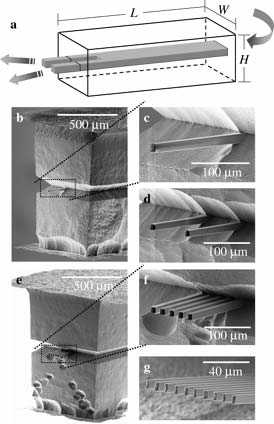APPLICATIONS OF TECHNOLOGY:

(a) Schematic view of a nanoelectrospray emitter with two protruding nozzles. (b) SEM image of a protruding single-nozzle spray emitter. (c) Magnified image of the nozzle that is 10 µm wide and 12 µm deep. (d) Double-nozzle emitter (10 x 12 µm). (e) Five-nozzle emitter. (f) Zoom-in image of (e) (10 x 12 µm nozzle). (g)Ten-nozzle emitter (2 µm wide and 8 µm deep nozzle).
- Multinozzle electrospray emitters for proteome-on-a-chip
- Mass spectroscopy of peptides and biomolecules with a wide range of weights
- Process for fabricating complex silicon-based bioanalytical tools
ADVANTAGES:
- First monolithic interface between mass spectrometry and silicon based microfluidic technologies
- Can be massed produced from silicon wafers
- Promises to be up to 20 times less expensive than current state-of-the-art tips
- Stability and sensitivity equivalent to or greater than commercial tips
- Extremely high resolution, accuracy and dynamic range
- Excellent ionization efficiency
- Array line densities of 100 nozzles/mm
- Biocompatible
DESCRIPTION:
Using a silicon microfabrication process, Daojing Wang, Peidong Yang, and colleagues at Berkeley Lab have developed inexpensive monolithic multinozzle micro (M3) emitters for electrospray ionization mass spectrometry. This invention is the enabling component for monolithically integrating mass spectrometry with microfluidic devices and realizing the potential of lab-on-a-chip proteomics.
In tests using a standard peptide and high molecular weight proteins, the M3 emitters demonstrated stability and sensitivity equivalent to commercial silica-based capillary nanoelectrospray tips. With further optimization, the Berkeley Lab emitters are expected to quickly surpass their commercial counterparts.
The M3 emitters can be mass-produced in various sizes and in arrays with line densities of 100 nozzles/mm. Each emitter consists of a parallel silica nozzle array protruding from a hollow silicon sliver with nozzle sizes as small as 100 X 10 µm. The process requires only one mask and five major steps and could also be used to fabricate other complex bioanalytical tools. The M3 emitters are expected to be ~ 20 times less expensive than nanoelectrospray tips currently on the market.
STATUS: Issued U. S. Patent #8022361. Licensed. Contact ipo@lbl.gov to discuss remaining fields of use.
SEE PUBLICATION:
REFERENCE NUMBER: IB-2211
SEE THESE OTHER BERKELEY LAB TECHNOLOGIES IN THIS FIELD: